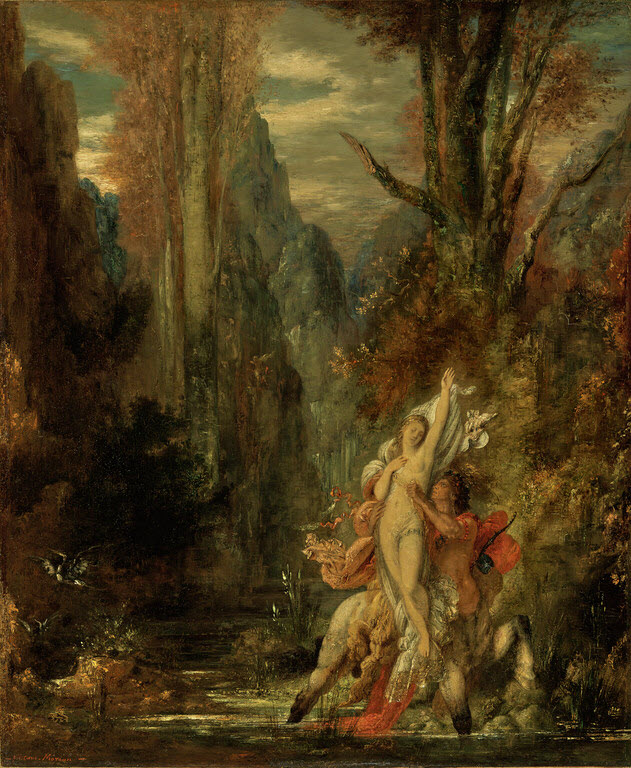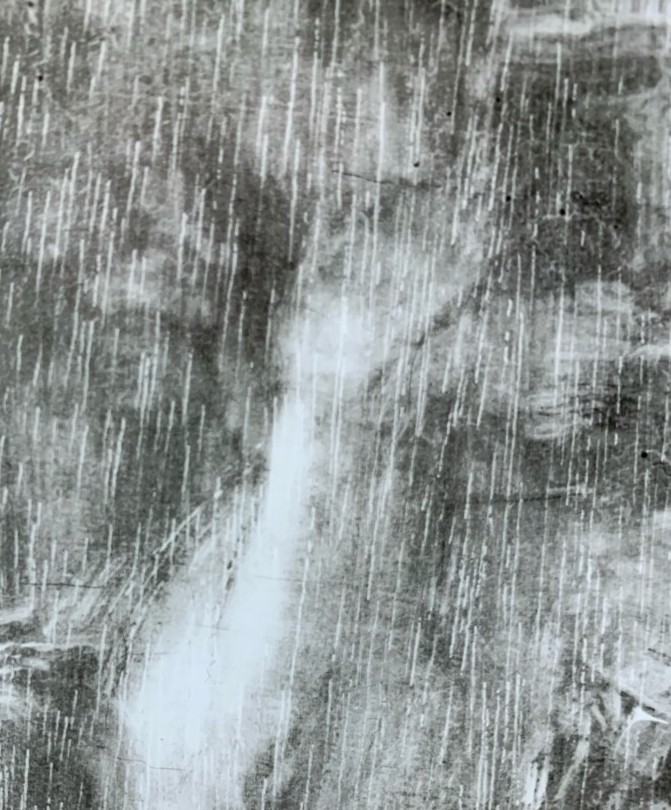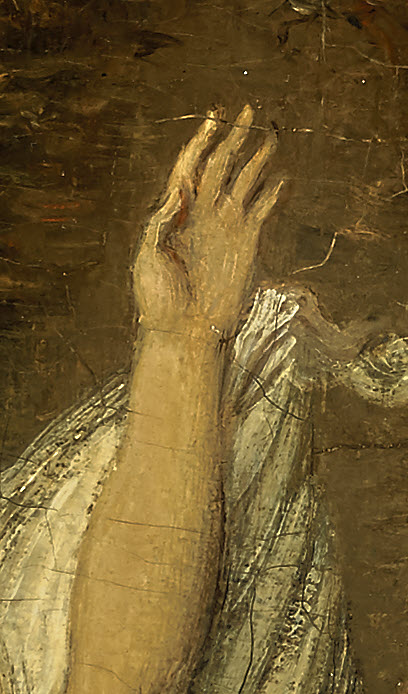Just a few years older than Édouard Manet (1832–1883) and the Impressionists who emerged in the 1860s and 1870s as champions of the painting of modern life, Gustave Moreau was by contrast a fervent traditionalist and romantic idealist. He was dedicated to the study of venerable antique and Renaissance models in Italy and the Louvre and to a hierarchical vision of painting in which allegorical, mythological, and Biblical subjects still reigned supreme. But however reactionary Moreau was, he was not a hidebound academic, and the degree of poetic imagination and pictorial inventiveness he brought to old themes — the Getty’s Dejanira (Autumn) being a case in point — sets him apart.
The Metamorphoses by the ancient Roman poet Ovid was one of Moreau’s principal literary sources, and the abduction of Dejanira was one of several episodes from the life of Hercules that occupied his attention. As with other favorite mythological subjects, Moreau treated this one obsessively, creating more than 150 figure drawings and compositional studies, several unfinished oil paintings, and variations in watercolor and sculpture.1 The Getty Museum’s highly finished panel painting, commissioned in 1872 by the Parisian stockbroker and collector Louis Helmut Lepel-Cointet (1829–1881), is only one manifestation of an artistic meditation that extended from the late 1860s through the early 1890s and underwent many permutations.
Ovid’s narrative is one of dramatic violence. The poet recounts in the ninth book of the Metamorphoses how Hercules and his new bride Dejanira, whom he had recently won in a contest with the river god Achelous, are blocked by the raging river Evenus on their way home to Hercules’s native city. The centaur Nessus nefariously offers his services as ferryman and Hercules entrusts him with Dejanira. The lustful centaur promptly abducts her as Hercules swims across the river and gains the opposite bank. Hearing his wife’s plaintive cries, Hercules proceeds to slay Nessus with an arrow tainted with the poisonous blood of the Lernean hydra. In his dying moments, Nessus gives Dejanira his blood-soaked tunic and treacherously claims that it would prove an aphrodisiac. Years later, hearing rumors of Hercules’s infidelity, Dejanira would tragically cause her husband’s death by sending him the tunic in the hopes of reconquering his love.2
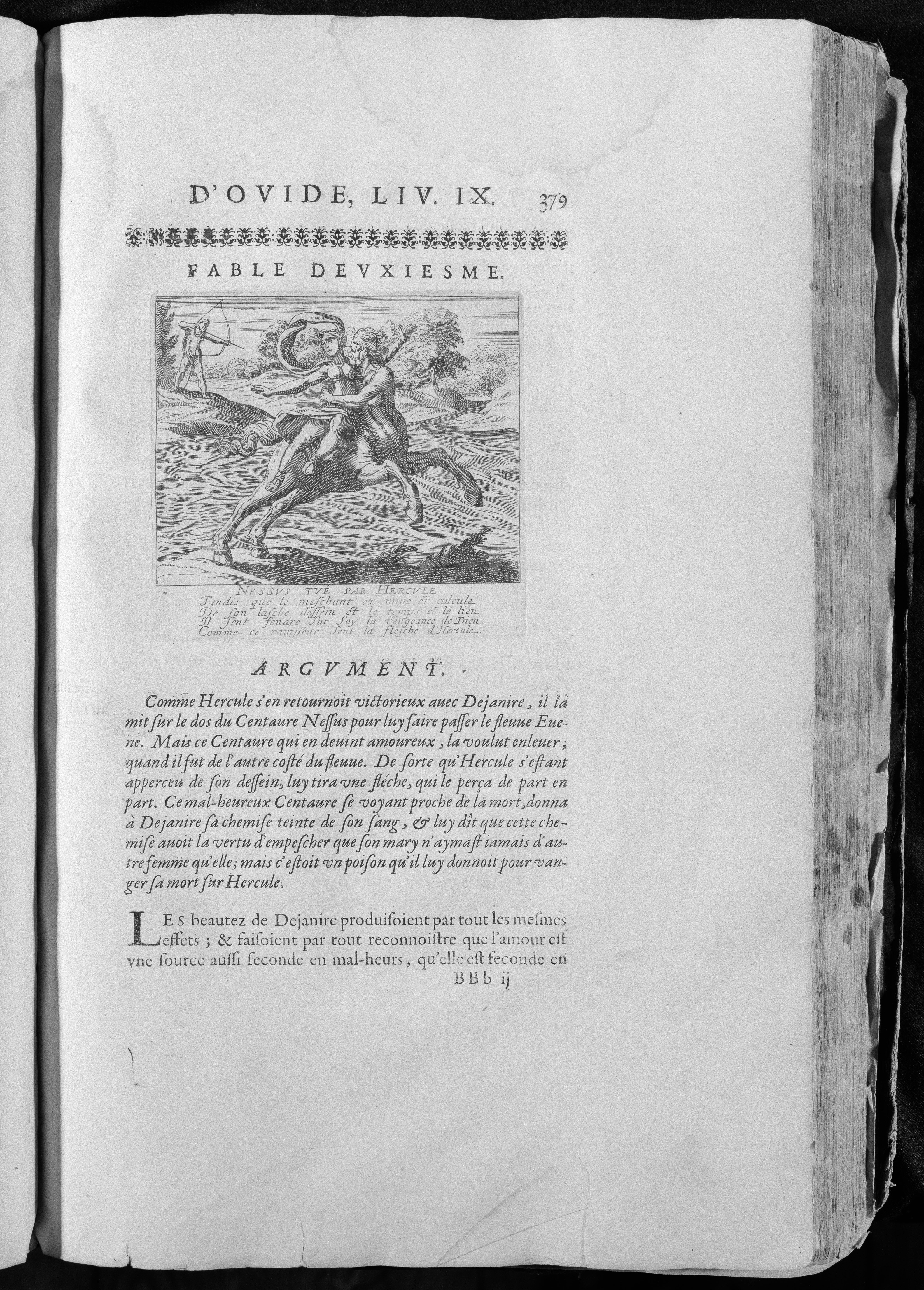
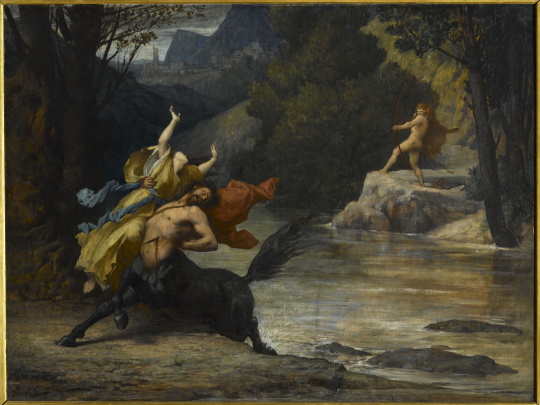
Dejanira’s abduction was one of several mythological rape scenes that occupied Italian and French painters from the sixteenth through the eighteenth centuries.3 In keeping with Ovid’s tale, artists typically emphasized Nessus’s bounding lust, Dejanira’s desperate struggle, and Hercules’s angry pursuit. Representative of this tradition is the engraved illustration in a 1660 edition of Ovid in Moreau’s library (fig. 1),4 and, more immediately, his friend Jules-Élie Delaunay’s version of the subject for the 1870 Paris Salon (fig. 2).
Moreau was well versed in the iconographic and pictorial tradition that informed such works as Delaunay’s. In several drawings he employed the standard, diagonally recessive composition to capture the speed of flight and chase. In a rapid figure study (fig. 3), Moreau’s Nessus summons, in a flurry of pencil strokes, the muscular energy of the centaur as depicted, for instance, by Louis Jean François Lagrenée in his 1755 reception piece for the Royal Academy (fig. 4), while Dejanira’s prone position on the centaur’s back recalls Giambologna’s bronze versions of the subject5 and also Michelangelo’s famous design for another mythological rape scene, Leda and the Swan.6 In a more developed compositional study squared for transfer (fig. 5), Moreau emphasized Nessus’ gruesome death with an agonized grimace, as Delaunay had done. Here Dejanira’s pose evokes the serpentine movements of Giambologna’s and Bernini’s sculptural representations of mythological rape,7 while Hercules’ pose and relegation to the background on the right finds its source in Guido Reni’s famous Nessus and Dejanira (fig. 6), a picture Moreau would have known well from his time studying in the Louvre. From this brief sampling it is evident that Moreau immersed himself in art historical tradition, looking both to the established iconography for his Ovidian subject and to a wider field of mythological representations where he could find thematic echoes and formal solutions for his evolving composition.
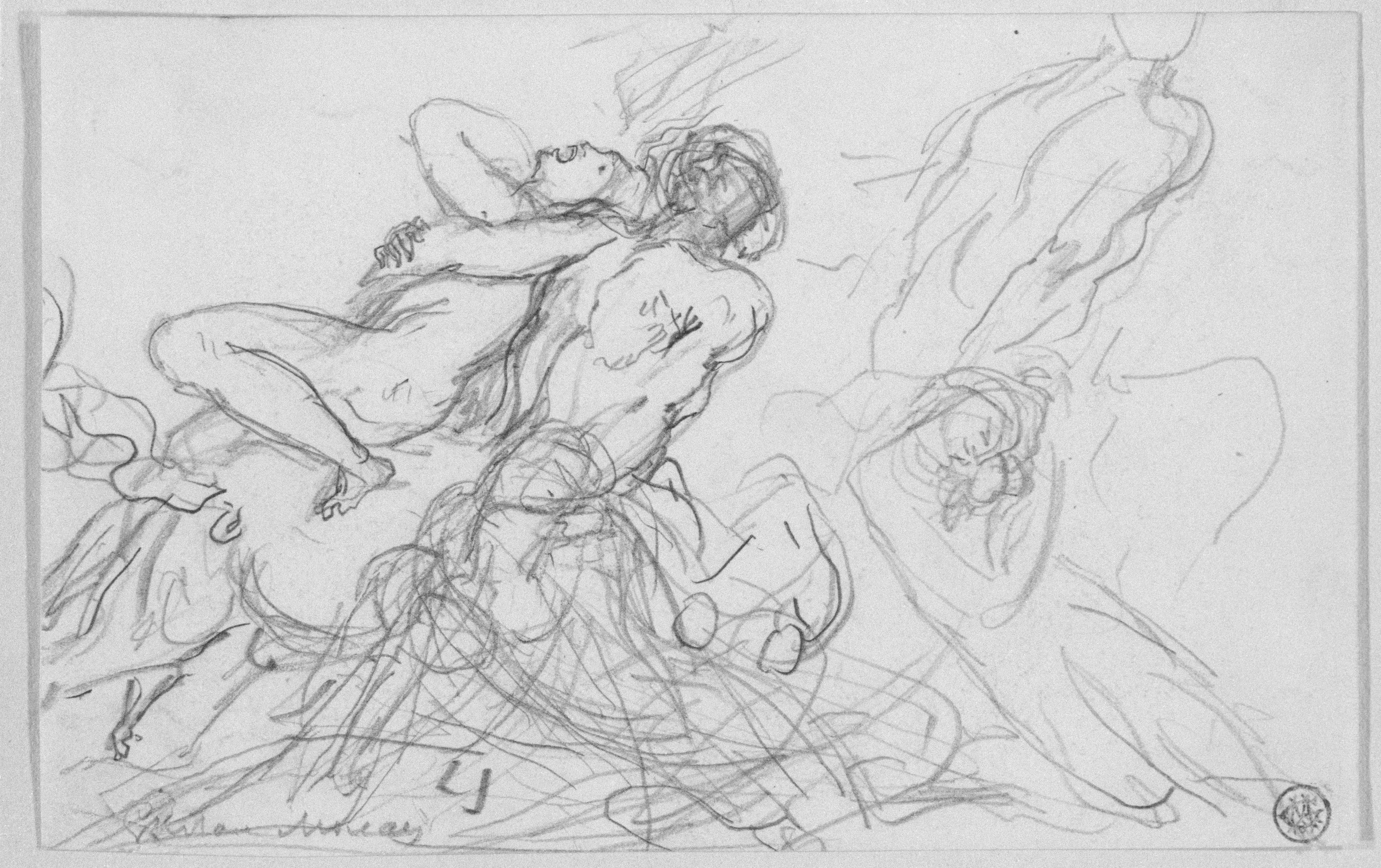
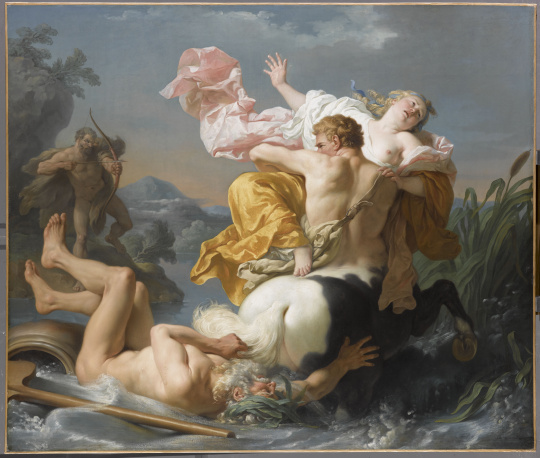
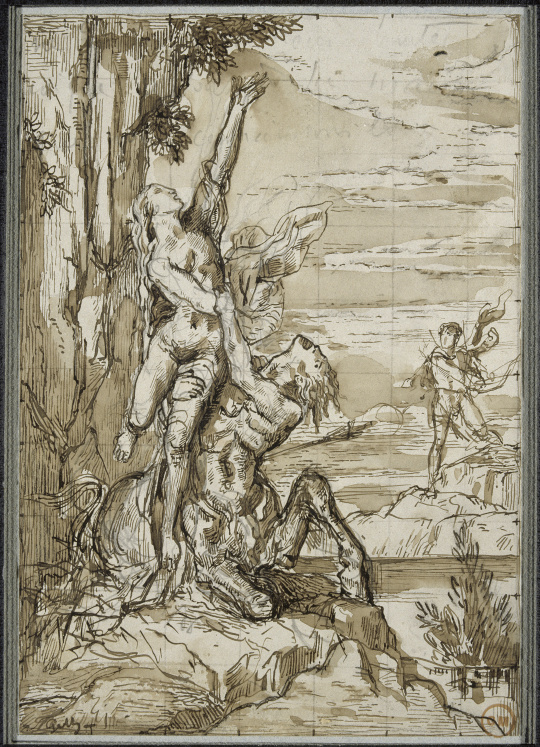

Moreau, however, rehearsed tradition only to repudiate it. The bulk of his studies testify to his efforts to reinvent his time-worn theme. It is impossible to reconstruct the exact sequence of Moreau’s studies, considering that many sketches never proceeded past his première pensée and that he experimented with different figure arrangements simultaneously, but one can trace the progressive restraining of dramatic rhetoric in his more developed studies.8 After transferring to canvas the squared composition discussed above (see fig. 5), he began tempering its emotional intensity by replacing Nessus’s grimace with a calmer, more focused gaze and by de-emphasizing the arrow in his back (fig. 7). In other compositional studies, he would increase the psychological tension by stressing the moment before Nessus is shot (fig. 8). Dejanira still struggles, but the centaur now grasps her imploringly while striding through the water. Moreau defuses the physical drama further by decreasing the figure scale and introducing a more elaborate landscape, in which the stagnant calm of the river contrasts pointedly with Ovid’s turbulent Evenus. Hercules has receded farther into the background, now appearing high on a cliff, only to be marginalized further when Moreau increased the height of the cliff in subsequent studies. In drawings closely linked to the Getty painting, Moreau again reduced the figure scale and increased the elevation of the mountains and trees (fig. 9). In the finished painting, Hercules is obscured in the shadow of the rock face, the ghostly residue of a once heated drama.
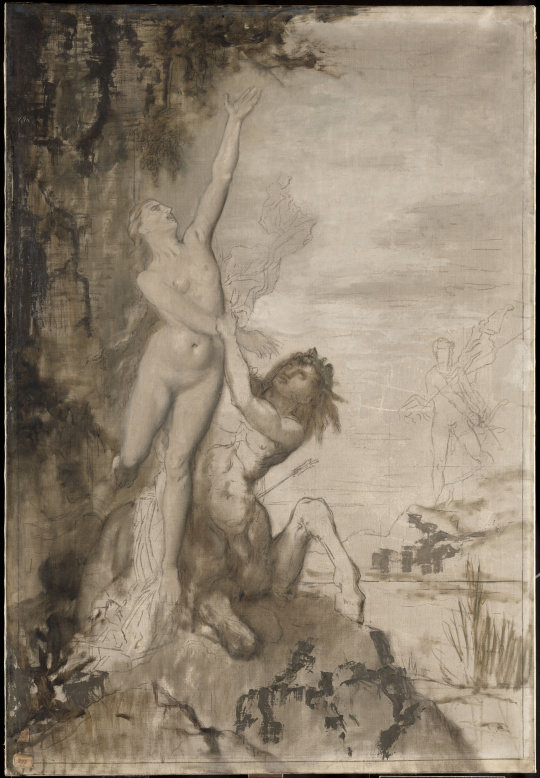
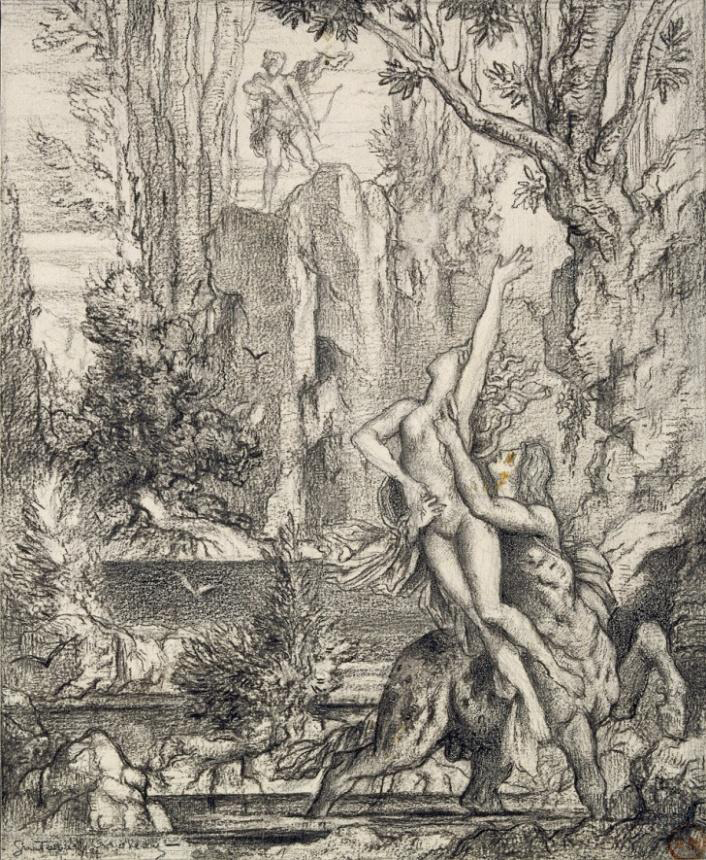
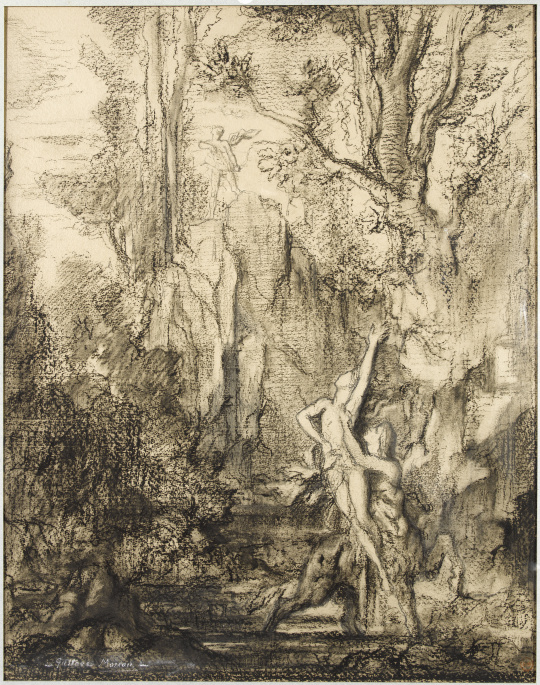
Over the course of this development, Moreau dramatically altered Dejanira’s pose, purging his subject of all remaining traces of violence and struggle. He rejects mannered exuberance for a rarefied somnolence — but only after experimenting manically with her pose. In a proliferation of studies, he showed her frontally and in profile, her expression alternately terrified or at ease, while her left and right arms are alternately thrown into the air, bent behind her head, or stretched, strained, or slumped across her chest. Moreau eventually contained her arms against her body, just as he folded one leg behind the other. As if exhausted by her struggle, Dejanira becomes an image of calm self-absorption (fig. 10). From this point, Moreau only made minor adjustments. He extended the arm folded behind her head upwards, returning it in fact to an earlier position (fig. 11). Finally, he changed the position of her hand. The x-radiograph of the Getty painting suggests that the hand was first flung to the side, as in the preparatory drawings; repainted, it becomes more rigid and hieratic, pointing straight upwards (figs. 12–13).
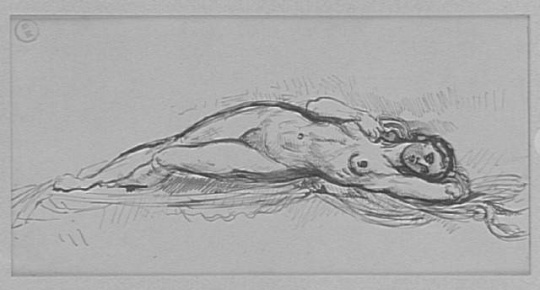
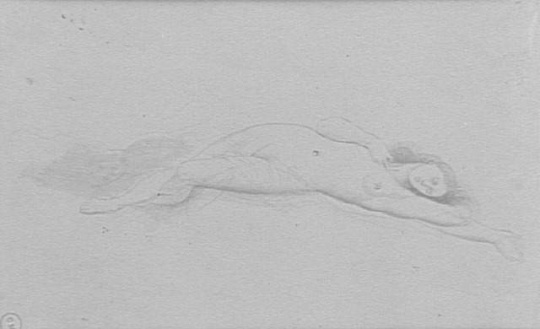
A parallel movement away from physical drama is evident in Moreau’s studies for Nessus, the centaur gradually assuming a more dignified, upright bearing. Moreau proceeded in academic fashion, doing independent studies of horse and human figure and then combining them (figs. 14–15). After having explored reversals and variations of pose, Moreau eventually settled on a three-quarter view of the horse with its left foreleg raised. For the centaur’s human half, Moreau incorporated studies of a male nude in a pose derived from the famous ancient bronze statue of a dancing faun in the Museo Archeologico in Naples, a plaster reduction of which Moreau kept in his studio.9 Hardly a model for the centaur’s libidinal excess, Moreau’s balletic fawn (not unlike Reni’s Nessus) advances gracefully forward, his chest gently twisting and his outstretched arms following his upward gaze.
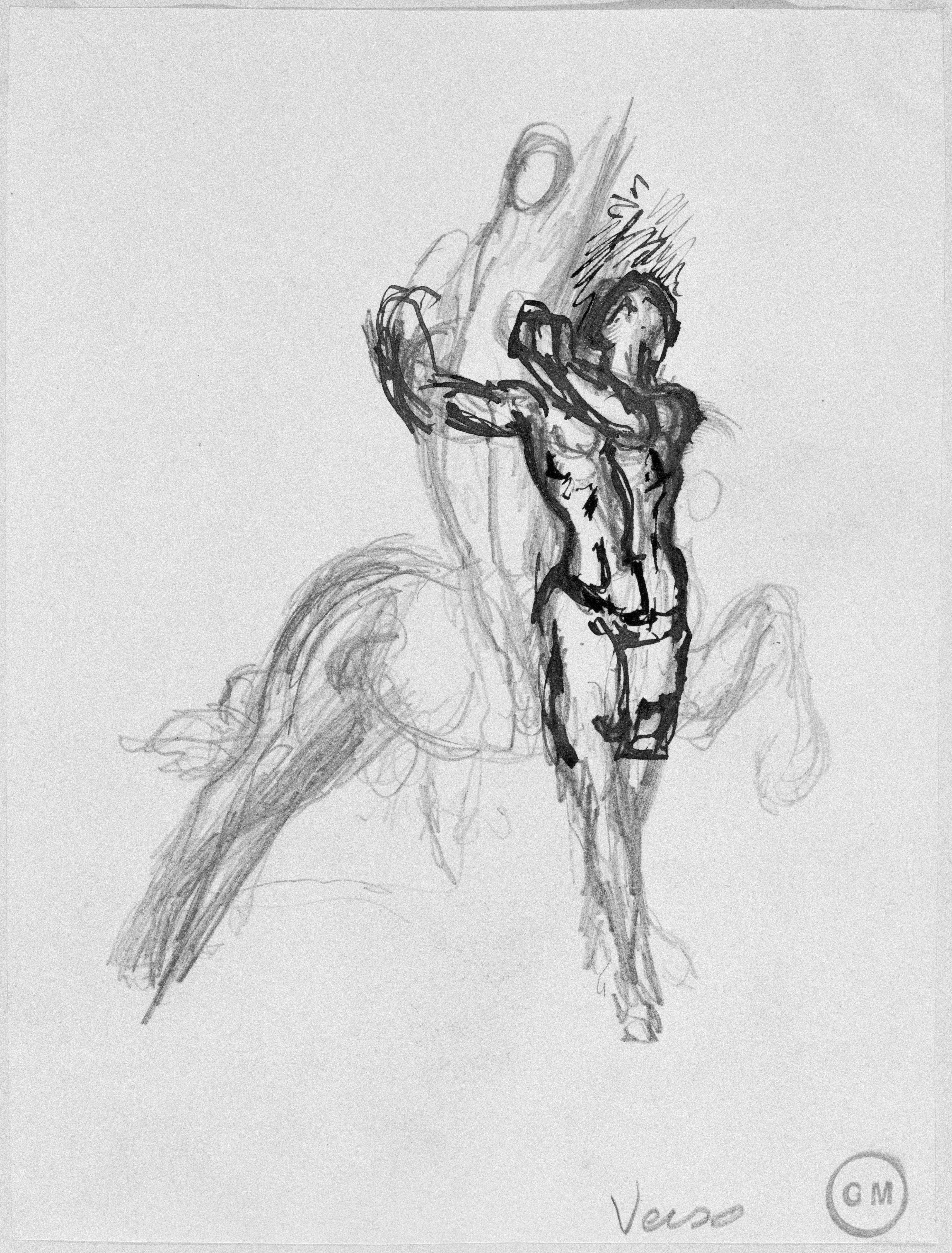
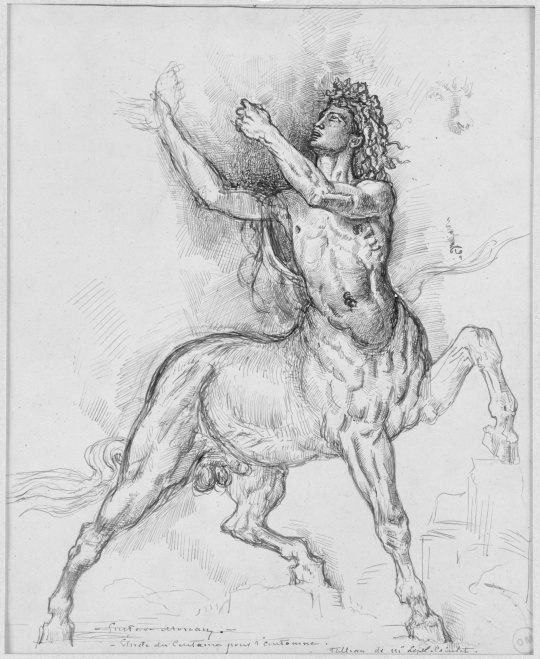
Moreau’s renunciation of the violent sexual drama inherent in the myth is indicative of his guiding ambition to revitalize and ennoble contemporary history painting.10 Echoing the anxious refrains of conservative critics, Moreau was preoccupied in his private writings with the impoverishment of modern French art. He accused artists of becoming slaves to tradition in their lack of poetic imagination. Painters had become content to merely follow the letter of classical texts and debase them by producing theatrical tableaux vivants in which the vulgar facial grimace was the dominant mode of expression.11 For Moreau the crude immediacy and shameless accessibility of such works represented the prostitution of art.12 More generally, artists had been corrupted by an abhorrent spirit of positivism and materialism that promoted a low idea of artistic truth based on external appearances. With this focus on the familiar and superficial, history painting had degenerated into mere genre.13
Some of these criticisms might be extended to Delaunay’s The Death of Nessus (see fig. 2). Delaunay had, for example, closely followed his literary source, not Ovid as usually assumed but Philostratus the Younger’s ekphrasis in the Imagines: “Do you see the centaur giving his last leap? […] Dejanira is painted in the attitude of one in danger, […] stretching out her arms to Heracles, while Nessus […] has just been hit by the arrow and is in convulsions.”14 In taking up the ekphrastic challenge as painters had previously done, Delaunay surely sought to situate himself in the grand tradition of history painting. Critics responded uneasily, however, for Delaunay’s close adherence to his source was matched by a literal-minded academic realism that seemed to compromise the poetic ethos of the myth. Marius Chaumelin, for example, attacked Delaunay for failing to achieve a harmonious transition between the centaur’s equine and human parts; worse, there was “nothing divine in this centaur. He cries and grimaces like a simple mortal.”15
Moreau formulated his conception of “epic” painting in opposition to such tendencies. Instead of adhering closely to his classical sources, he espoused what he called — in reference to Nicolas Poussin, one of his heroes — the “sublime logic” of an imagination that admitted iconographic unorthodoxies in the service of poetic expression and higher allegorical truths. Indeed, “history painting” was “a misnomer, because great art does not take its elements […] from history. It takes them from pure poetry, from high imaginative fantasy, and not in historical facts except in order to allegorize (symbolize) them.”16 Correspondingly, instead of enlisting rhetorically bankrupt means of gesture and grimace, Moreau would create a “mute,” chastened art that embodied an ideal of spiritual interiority,17 and that would rely in part on the rapt contemplation of the idealized, and immobilized, human form.18
Moreau’s evolving pictorial conception of the abduction of Dejanira is exemplary of these aspirations away from excessive theatricality and toward his poetic and plastic ideal of “epic” art. We might also understand the pictorial development of Dejanira as enacting a process of allegorization, whereby Moreau sought to invest Ovid’s tale with levels of meaning beyond the surface narrative.
When Moreau first undertook the subject of Dejanira, he saw it as part of a series based on Hercules’s life and labors.19 Indeed, he made clear visual connections between his various treatments of Herculean subjects to underscore the point. Nessus’s contorted pose and expression in one of the compositional studies discussed above (see fig. 5), for instance, derived from the figure of Diomedes being devoured by his own horses in a painting Moreau had exhibited in the 1866 Salon.20 Moreau thereby linked two victims of Hercules: Nessus being punished for his feral lust for Dejanira, and Diomedes for a bloodlust indulged by gorging his savage horses on human victims. Hercules’s headlong rush in the same study is duplicated in variations of Hercules and the Stymphalian Birds and Hercules and the Brazen Hind, dating from the mid-1860s to the early 1870s.21 Here, like the hind and the birds, Nessus embodies the primitive forces that Hercules, as civilizing agent, must subdue.
Moreau abandoned such connections as he developed his theme. By the early 1870s, he had begun to conceive a series based on the four seasons, in which the abduction of Dejanira would serve as an allegory of autumn. Soon after completing the Getty painting, Moreau explained his new conception in a letter he drafted for Lepel-Cointet:
The Dejanira is one of four compositions representing the four seasons of the year. Leaving the story aside, here is what I have imagined: I have tried to render the harmony that may exist between the world of external nature at a certain time of year and certain phases of human life. / In a veiled landscape pierced with a luminous ray, the centaur seeks to embrace and hold onto this white and graceful form, which is about to escape him. It is a last gleam, a last smile of nature and life. Winter threatens. Night is coming on. It is autumn.22
Hardly the sinful, treacherous figure presented in the moralizing glosses on Ovid’s Metamorphoses that were common in the Christian tradition (Moreau’s 1660 edition is a good example),23 Nessus has instead become a figure of romantic nostalgia.
Lepel-Cointet did not entertain any special interest in mythological subjects and apparently played no role in the allegorical conception of Dejanira (Autumn). In 1872 he wrote to the artist and stated simply that “the hope of possessing a picture by you fills me with joy. The subject matters little, [and I am] assured in advance that, interpreted by you, it will leave nothing to be desired.”24 Although Moreau was following established tradition in choosing a mythological subject for his seasonal allegory, the obsessional nature of his interpretation is exceptional. He went to great lengths to cultivate meaningful connections between works within his own oeuvre and within a broader field of art so that Dejanira and Nessus acquired the archetypal resonance necessary to sustain the symbolic correspondences he imagined between “certain phases of human life” and “the world of nature.” Indeed, the confrontation between Nessus and Dejanira ultimately comes to allegorize the same poetic, essentially neoplatonic aspirations that governed Moreau’s “epic” art in general.
Dejanira was an ambivalent figure for Moreau, as the sudden reversals in his studies for her suggest. Though his early compositions show her straining back toward Hercules, Moreau excised her from narrative context in many related figure studies, where her attitude could be interpreted as one of arch defiance (fig. 16). Displayed in haughty profile with one arm akimbo, the other thrown aloft, she assumes an imperious independence, exfoliating draperies prolonging her artful pose. Surprisingly this attitude derives from one of the effeminate princes in Moreau’s The Suitors, a painting loosely based on Homer’s Odyssey that had occupied him since the 1850s (fig. 17). Such an odd duplication of figures not only blurs gender distinctions but also confuses the roles of victim and aggressor. Hardly the innocent wife, this insolent suitor threatened Odysseus’s marriage; hardly saved by the hero’s arrow, this beautiful androgyne is slain by it (we see Odysseus drawing his bow in the background, much like Hercules). Given such a conflation of figures, Dejanira anticipates the late-nineteenth-century femme fatale. Like Moreau’s Salome or Helen of Troy, she becomes the beautiful instigator, at once passive and aggressive, of a sequence of tragic events; we might remind ourselves that the Greek name “Deianira” translates into “fighter-with-men” or even “man-killer.”25
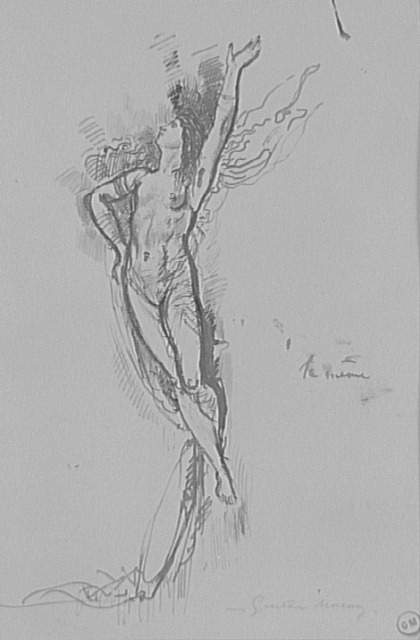
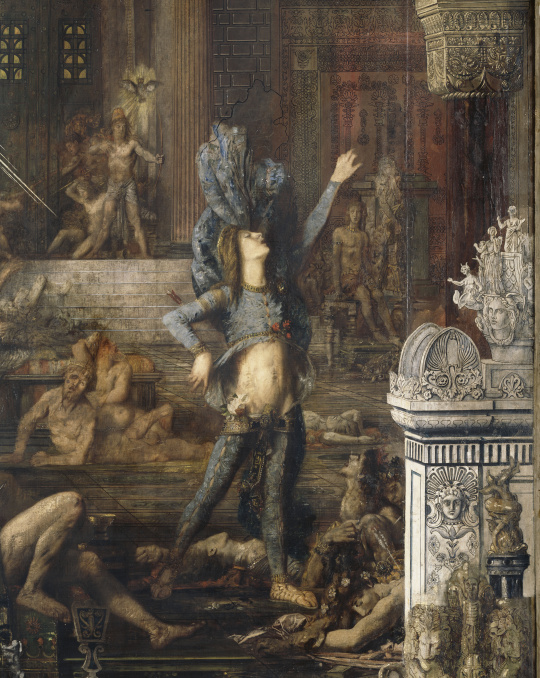
In the end Moreau detached Dejanira from the realm of terrestrial passions, presenting her as self-contained, slumbering and self-absorbed. As such she joins innumerable other “white and graceful forms” in Moreau’s work that descend from the nudes of Botticelli, which he so admired.26 Unusual, however, is the strangely weightless suspension of her body, an effect that Moreau achieves by taking the classical type of the sleeping Venus and, quite simply, presenting it vertically (see figs. 10 and 11)! Defying gravity, Dejanira becomes a pointed response to the refulgent carnality of such recumbent nudes as Alexandre Cabanel’s Birth of Venus (1863 Salon),27 which for Moreau emblematized the prostitution of contemporary history painting. Dejanira carries instead that air of “ideal somnambulism” that Moreau found in certain of Michelangelo’s figures and that signaled their perfect interiority and transportation to an abstract, spiritual realm.28
Moreau’s allegorical conception crystallized with this change in Dejanira’s pose. In one study squared for transfer, he labels her “Automne.”29 Elsewhere, he would duplicate her pose, place some traditional emblems under her feet, and call her “Fortune.”30 Elevated above the base contingencies of narrative, Dejanira is refashioned as an emblem. As if to underscore her new allegorical role, Moreau lifted her arm. Even in her vertical orientation, she may still have evoked numerous erotic depictions of the Venus Anadyomene or The Source. With an upraised arm, however, she would also echo such figures as Jules-Joseph Lefebvre’s Truth (1870 Salon),31 or the central figure of Puvis de Chavannes’s much-admired Autumn (1864 Salon), an idealized scene of the vintage.32 Considering such points of reference, Dejanira appears to be an amalgam of distinct types. Evoking the moral idealism of allegorical personification (without its stern countenance) and the sensuality of the reclining nude, Moreau neatly combines emblems of Truth and Beauty, creating a seductive incarnation of an abstract ideal that holds Nessus in thrall.
In keeping with his reinvention of Dejanira, Moreau recasts Nessus as a romantic emblem for the tragic poetic aspiration toward an unattainable ideal. The majority of Moreau’s studies concentrate on investing Nessus with the mythic nobility that Chaumelin had found lacking in Delaunay’s centaur. Nessus’s dignified bearing in the Getty painting recalls Renaissance equestrian monuments, suggesting a sovereign mastery over animal instinct. In this respect, Nessus bears no family relation, for instance, to the centaurs depicted in Louis-Frédéric Schutzenberger’s 1864 Salon painting of a boar-hunting rampage,33 or in Eugène Fromentin’s 1868 Salon painting, a pseudo-orientalist scene with indolent female centaurs watching their juvenile male counterparts killing a bird.34
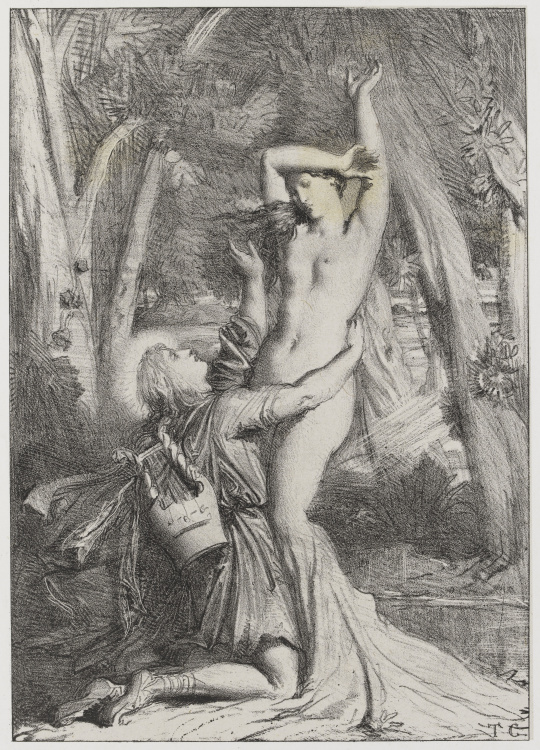
To address specifically the “divine” portion of the centaur’s nature, Moreau drew an imaginative parallel between Nessus and Apollo, god of poetry. He turned to his mentor Chassériau’s idiosyncratic painting of Apollo and Daphne from the 1840s,35 a lithographic reproduction of which he owned (fig. 18). Rather than presenting the nymph fleeing from Apollo, Chassériau showed her towering impassively above the love-struck god. Her sinuous form, attenuated by tree roots flowing from her legs, anticipates Dejanira’s tantalizing suspension in Moreau’s work. In a poem inspired by Chassériau’s painting, Marc Fournier emphasized the poet’s yearning for an impossible spiritual and physical beauty,36 while Paul Leprieur would in turn refer to Chassériau’s image while discussing the importance of this theme in Moreau’s work: “This Apollo […], is it not the image of the dreamer, whoever he is, musician, poet or painter, trying in vain to reach the elusive ideal […] which vanishes the moment one thinks one has grasped it?”37 The centaur, who in Moreau’s words “seeks to embrace this white and graceful form, which is about to escape him,” surely counts among these “dreamers.”
Correspondingly, Moreau’s painting resonates with his depictions of archetypal poet figures, and one may situate it within an overarching set of analogies he established between seasons or times of day and stages of poetic inspiration and loss. As the autumnal “last gleam” of a poetic ideal, the painting finds a companion in Hesiod and the Muses, in which spring allegorizes the awakening of poetic inspiration.38 Here the muse kneels in adoration before the poet; spring morning replaces autumn evening; and the numerous birds sporting around Hesiod — what Moreau called sacred “emblem[s] of purity”39 — replace the solitary bird taking flight in Dejanira (Autumn). To fill out the cycle, one might turn to Orpheus at the Tomb of Eurydice, Orpheus being another recurring poet figure in Moreau’s art. Here he shows Orpheus in a martyr’s pose against a blasted tree in a bloody-hued nocturnal landscape with a pallid sepulchre, all of these elements suggesting death and isolation, the silencing of the poet’s voice and lyre.40
As Dorothy Kosinski has shown with reference to Moreau’s ambitious polyptych, The Life of Humanity, Moreau mapped the whole trajectory of human civilization onto natural cycles.41 Within this universalizing scheme, the Poet represents Hesiod’s Silver Age of humanity, a time before the fall from grace when a youthful civilization still found intuitive, impassioned expression through myth. A poignant image of the irrevocable loss of this mythical age, the centaur mourning the death of the poet became a recurring motif in Moreau’s art. As Douglas Druick has written of the Dead Poet Carried by a Centaur, an 1891 watercolor, the “poet and centaur are the last of their kind – the sun setting on the tradition which they represent” (fig. 19).42 The solemn, crepuscular mood pervading Moreau’s Dejanira shares in the same spirit of historical mourning. Indeed, the composition of the Dead Poet finds a close variant in a version of Autumn that also probably dates to the early 1890s (fig. 20). Nessus, or rather the centaur more generically, has come to represent aspirations and sufferings similar to those of the Poet himself.
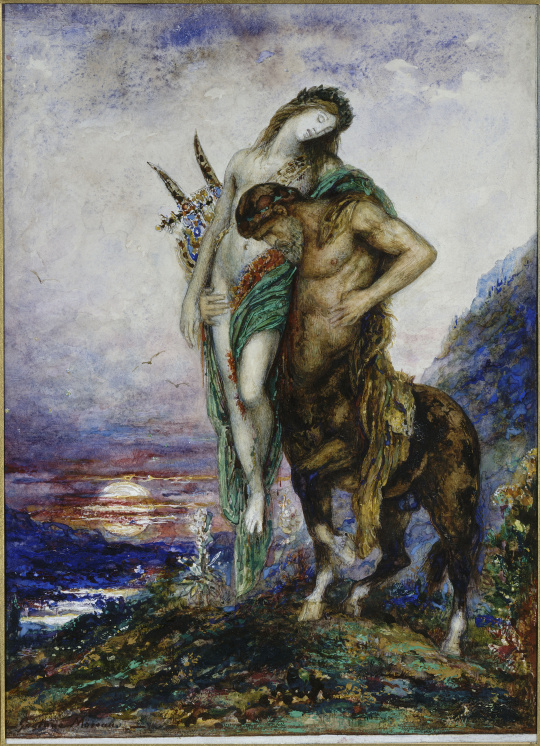
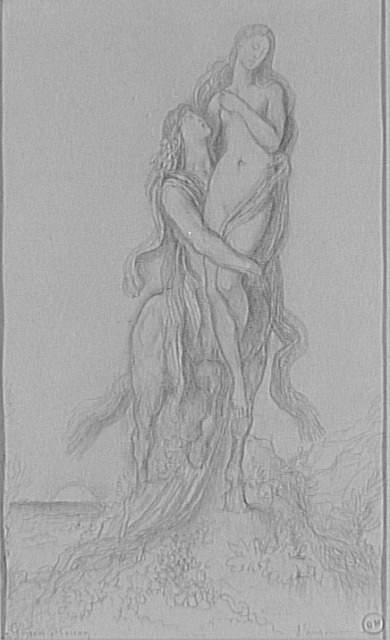
Fated as he was by his hybrid nature, however, the centaur could never fulfill these spiritual aspirations and penetrate, like Orpheus, the divine mysteries of nature. Such at least was the fate of the centaur as memorably imagined by romantic poets like Maurice de Guérin.43 In keeping with this romantic tradition, Moreau used the centaur as a metaphoric vehicle for the wrenching moral opposition between the physical and the spiritual, an opposition that provided a philosophical framework for his art more generally.
Moreau reinforced this symbolic opposition in the landscape setting of Dejanira (Autumn), which, as we have seen, became increasingly prominent as the composition developed.44 Moreau effectively hypostatized his figural drama in nature, duplicating the confrontation between Nessus and Dejanira in the two trees framing the composition. The poplar on the left echoes Dejanira’s rigid verticality and otherworldly pallor, while the gnarled tree on the right matches the centaur’s twisting pose and darker coloring. Even the broken branch silhouetted against the sky parallels Nessus’s outstretched arm.45 As elsewhere in Moreau’s art, the white poplar is meant to suggest the poetic aspiration to the divine,46 while the broken tree emblematized thwarted desire and the loss of love and poetic inspiration, as in Orpheus at the Tomb of Eurydice. All of Moreau’s romanticism is neatly condensed in the opposition of these two trees.
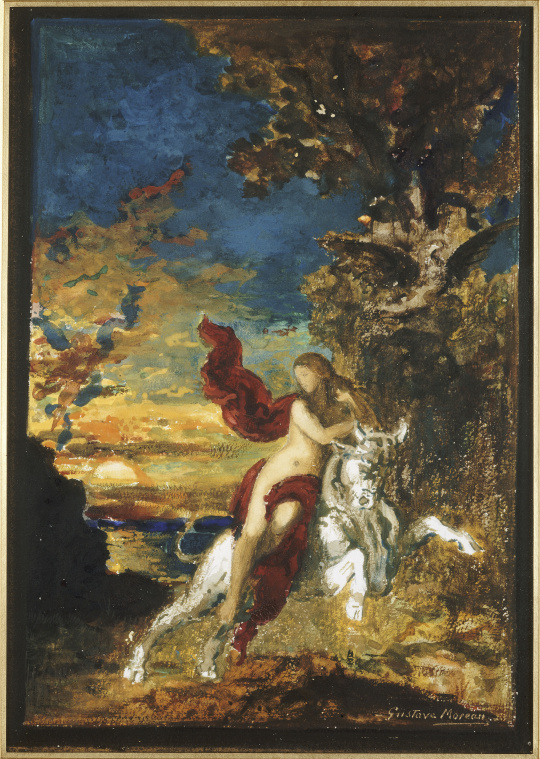
Given Moreau’s dualistic scheme of oppositions, staged here through an archetypal male/female confrontation, the artist had little room left for Ovid’s third and principal figure, Hercules. Rather than eliminate him entirely, however, Moreau cast him in an accessory role analogous to that played by Cupid in his other mythological abduction scenes. In several versions of Europa, for example, Moreau presented the airborne Amor in a manner remarkably similar to the fluttering Hercules in Dejanira (fig. 21). But where Cupid appears to impel divine love (Moreau interpreted the Europa theme in grandiose terms of divine potency, female rapture, and spiritual revelation),47 Hercules would deny that possibility to Nessus. He functions as Cupid’s negative double, firing his deadly arrows from atop a mountain just as the little god had done in the Metamorphoses when he vindictively sparked Apollo’s desire for Daphne, something the classically-educated Moreau undoubtedly would have recalled when finding inspiration for Dejanira in Chassériau’s Apollo and Daphne.
The complex pictorial development of Dejanira (Autumn) demonstrates how Moreau took his familiar mythological subject only as a point of departure, entangling it in a dense tissue of imaginative association and suggestive, open-ended analogy. As he rehearsed and distanced himself from the existing iconographic tradition, he established a complex visual and thematic interplay among his own inventions by freely recycling, duplicating, reversing, and conflating figures and poses from different narrative contexts. He did this not simply as a compositional expedient, but to elevate his subject to the level of archetypal generality, ultimately distilling from Ovid’s violent episode a poignant seasonal allegory of spiritual aspiration and loss that found its most complete expression in the Getty panel.
- Scott C. Allan
-
This essay is adapted from the original English text of my essay, “Les métamorphoses de L’Automne (Déjanire) de Gustave Moreau,” Revue de l’art, no. 137 (2002–3), pp. 49–62. Nearly all of the works on the Dejanira theme are preserved in the Musée Gustave Moreau, Paris. They are catalogued in Catalogue des peintures, cartons, aquarelles exposés dans les galeries du Musée Gustave Moreau (Paris: Éditions des musées nationaux, 1974); Paul Bittler and Pierre-Louis Mathieu, Catalogue des dessins de Gustave Moreau (Paris: Ministère de la culture; Editions de la Réunion des musées nationaux, 1983); and Marie-Cécile Forest, Gustave Moreau. Catalogue sommaire des dessins. Musée Gustave Moreau (Paris: Musée Gustave Moreau; Réunion des musées nationaux, 2009) (these last two publications covering drawings with inventory numbers up to 4830). On Moreau’s sculptural version of the theme, see Ragnar von Holten, “Gustave Moreau sculpteur,” La Revue des Arts 9, nos. 4–5 (1959), pp. 210–11. Digital images of most of the museum’s collection may be consulted online: https://www.photo.rmn.fr ↩︎
-
Ovid, Metamorphoses, trans. Mary Innes (London: Penguin, 1955), pp. 206–10 (Book IX, lines 104–273). ↩︎
-
See Andor Pigler, Barockthemen, vol. 2/3 (Budapest: Akadémiai Kiadó, 1974), pp. 127–30. ↩︎
-
See Geneviève Lacambre, “Gustave Moreau et son édition de 1660 des Métamorphoses d’Ovide,” Bulletin de la Société de l’histoire de l’Art français. Année 2007 (2008), pp. 343–51. ↩︎
-
Moreau would have known at least one of these from his studies in the Louvre. See Giambologna (1529–1608), The Abduction of Dejanira, ca. 1580. Bronze, 42.1 x 30.5 cm. Paris, Musée du Louvre, OA 11896: https://www.photo.rmn.fr/CS.aspx?VP3=SearchResult&VBID=2CMFCIKB3300E&SMLS=1&RW=1161&RH=716 (accessed July 6, 2020). ↩︎
-
Moreau owned a plaster cast of Bartolomeo Ammannati’s Leda, which was based on a lost cartoon by Michelangelo. Moreau would also evoke this design in his own version of Leda. See Geneviève Lacambre et al., Gustave Moreau e l’Italia, exh. cat. (Rome: Accademia di Francia, Villa Medici, 1996), p. 183, no. 17, ill. p. 71; and p. 203, no. 87, ill. p. 138. ↩︎
-
During his 1858–1859 sojourn in Italy, Moreau had ample opportunity to study Giambologna’s Rape of the Sabines in the Loggia dei Lanzi in Florence and Bernini’s Abduction of Prosperina and Apollo and Daphne in the Borghese collection in Rome. See Geneviève Lacambre et al., Gustave Moreau: Between Epic and Dream, exh. cat. (Chicago: The Art Institute of Chicago, with Princeton University Press, 1999), p. 119, under no. 46. ↩︎
-
Most of Moreau’s more finished figure studies relate to several main compositional stages, for each of which he began a painting on canvas. We can follow their progression mainly because Moreau used tracing paper to explore variations and reversals of pose, frequently revising tracings and then tracing the altered figures for subsequent studies. ↩︎
-
See Lacambre et al. 1996 (note 6), p. 181, no. 8, ill. p. 64. ↩︎
-
This subject is the focus of my Ph.D. dissertation, “Gustave Moreau (1826–1898) and the Afterlife of French History Painting” (Princeton University, 2007). ↩︎
-
Gustave Moreau, Écrits sur l’art (Fontfroide: Bibliothèque artistique & littéraire, 2002), vol. 2, pp. 240, 251–52. ↩︎
-
Moreau 2002 (note 11), vol. 2, p. 239. ↩︎
-
See Moreau’s speech about the historical genre painter Gustave Boulanger (1824–1888), whom Moreau succeeded in the French Academy. Moreau 2002 (note 11), vol. 2, pp. 342–43. ↩︎
-
Philostratus the Younger, Imagines, Eng. trans. Arthur Fairbanks (Cambridge and London: Harvard University Press/Loeb Classical Library, 1979), pp. 361–63. ↩︎
-
“[…] le Nessus, de M. Delaunay, se compose du torse d’un homme blanc grossièrement soudé au corps d’un cheval noir. L’intersection est si apparente qu’il serait impossible, — même à un païen, — de se faire la moindre illusion sur la vitalité d’un pareil monstre. Au reste, rien de divin dans ce centaure. Il pleure et grimace comme un simple mortel […].” Marius Chaumelin, L’art contemporain (Paris: Librairie Renouard, 1873), p. 390. ↩︎
-
“Le grand art est l’art des hautes conceptions poétiques et imaginatives – art improprement appelé pour la peinture ‘Peinture d’Histoire’ -, ce qui est un non sens, car le grand art ne prend pas ses éléments […] dans l’histoire. Il les prend dans la poésie pure, dans la haute fantaisie imaginative, et non dans les faits historiques, à moins de les allégoriser (symboliser).” Moreau 2002 (note 11), vol. 2, p. 349. ↩︎
-
In the context of a discussion of different pictorial styles and modes that constituted “the eternal eloquence of this mute language” (“l’éloquence éternelle de ce langage muet”), Moreau writes: “Oh noble poetry of living and passionate silence, beautiful the art that, under a material envelope, mirror of physical beauties, also reflects the great impulses of the soul, the spirit, the heart and the imagination, and responds to the divine needs of human beings of all times. / It’s the language of God.” (“O noble poésie du silence vivant et passionné, bel art que celui qui, sous une enveloppe matérielle, miroir des beautés physiques, réfléchit également les grands élans de l’âme, de l’esprit, du coeur et de l’imagination, et répond à ces besoins divins de l’être humain de tous les temps. / C’est la langue de Dieu.” Moreau 2002 (note 11), vol. 2, pp. 257–58. ↩︎
-
See Moreau’s comments about “l’immobilité contemplative du corps humain” in the context of his meditations on his composition The Suitors (Les Prétendants). Moreau 2002 (note 11), vol. 1, p. 54. ↩︎
-
Pierre-Louis Mathieu, Gustave Moreau, Eng. trans. James Emmons (Oxford: Phaidon, 1977), p. 120. ↩︎
-
Diomedes Devoured by his Horses, 1865. Oil on canvas, 138.5 x 84.5 cm. Rouen, Musée des beaux-arts, inv. 31-16-1: https://mbarouen.fr/fr/oeuvres/diomede-devore-par-ses-chevaux (accessed June 11, 2020). See also Lacambre et al. 1999 (note 7), pp. 99–101, no. 33. ↩︎
-
See, for example, Hercules at Lake Stymphalus, undated. Oil on canvas, 145 x 128 cm. Paris, Musée Gustave Moreau, cat. 85: https://www.photo.rmn.fr/CS.aspx?VP3=SearchResult&VBID=2CMFCI4BO50GB&SMLS=1&RW=1399&RH=716 (accessed Aug. 17, 2020); and Hercules and the Brazen Hind, undated. Oil on canvas, 143 x 105 cm. Paris, Musée Gustave Moreau, cat. 206: https://www.photo.rmn.fr/CS.aspx?VP3=SearchResult&VBID=2CMFCI4BOYQF5&SMLS=1&RW=1399&RH=716 (accessed Aug. 17, 2020). ↩︎
-
“La Déjanire fait partie de quatre compositions représentant les quatre saisons de l’année. Laissant de côté la fable, voici ce que j’ai imaginé: j’ai tenté de rendre l’accord qui peut exister entre la nature extérieure à un certain moment de l’année et quelques phases de la vie humaine. / Dans un paysage voilé, coupé d’un rayon lumineux, le centaure cherche à étreindre et retenir cette forme blanche et légère qui va lui échapper. C’est […] une dernière lueur, un dernier sourire de la nature et de la vie: l’hiver menace; bientôt la nuite. C’est l’automne.” Draft letter to Lepel-Cointet, repr. in Moreau 2002 (note 11), vol. 1, pp. 89–90. Moreau drafted this letter in response to the collector’s request for some explanation of the painting’s subject. In a letter of Oct. 9, 1873, the collector had to remind the artist of his request: “Je vous serais bien obligé à l’occasion, de m’envoyer la petite lettre que je vous ai demandée.” See Moreau 2002 (note 11), vol. 1, p. 184n97. ↩︎
-
The inscription in Moreau’s edition reads: “Nessus tué par Hercule. Tandis que le meschant examine et calcule / De son lasche dessein et le temps et le lieu / Il sent fondre sur soy la vengeance de Dieu / Comme ce ravisseur sent la flèche d’Hercule.” See Lacambre et al. 1996 (note 6), p. 206, under no. 96. ↩︎
-
“L’espoir de posséder un tableau de vous me comble de joie. Le sujet n’importe peu, assuré à l’avance qu’interpreté par vous, il ne laissera rien à desirer.” Letter from Lepel-Cointet to Moreau, dated May 11, 1872. Paris, Musée Gustave Moreau, Lepel-Cointet correspondence. ↩︎
-
See C. K. Williams and Gregory W. Dickerson’s introduction to Sophocles’ Women of Trachis (New York: Oxford University Press, 1978), pp. 51–56. ↩︎
-
The body type and pose of Dejanira have obvious similarities with the figure of Venus in Botticelli’s Birth of Venus, which Moreau copied in the Uffizi. See Lacambre et al. 1996 (note 6), p. 194, no. 64, ill. p. 114. ↩︎
-
Alexandre Cabanel (French, 1823–1889), Birth of Venus, 1863. Oil on canvas, 130 x 225 cm. Paris, Musée d’Orsay, RF273: https://www.photo.rmn.fr/CS.aspx?VP3=SearchResult&VBID=2CMFCIAZP0QFK&SMLS=1&RW=1385&RH=716 (accessed June 15, 2020). ↩︎
-
See Moreau 2002 (note 11), vol. 2, pp. 305–6; and Odile Sébastiani-Picard, “L’influence de Michel-Ange sur Gustave Moreau,” La Revue du Louvre et des musées de France 27, no. 3 (1977), pp. 140–52. ↩︎
-
Paris, Musée Gustave Moreau, des. 2004: https://www.photo.rmn.fr/CS.aspx?VP3=SearchResult&VBID=2CMFCIA0N87S0&SMLS=1&RW=1382&RH=716 (accessed June 11, 2020). ↩︎
-
Paris, Musée Gustave Moreau, des. 2783: https://www.photo.rmn.fr/CS.aspx?VP3=SearchResult&VBID=2CMFCIA0NWOZC&SMLS=1&RW=1382&RH=716 (accessed June 11, 2020). ↩︎
-
Jules-Joseph Lefebvre (French, 1836–1911), Truth, 1870. Oil on canvas, 110 x 62 cm. Paris, Musée d’Orsay, RF1981-29: https://www.photo.rmn.fr/CS.aspx?VP3=SearchResult&VBID=2CMFCIA00MXUZ&SMLS=1&RW=1382&RH=716 (accessed June 11, 2020). ↩︎
-
Pierre Puvis de Chavannes (French, 1824–1898), Autumn, 1864. Oil on canvas, 285 x 227.9 cm. Lyon, Musée des beaux-arts, inv. A 2963: https://www.mba-lyon.fr/fr/fiche-oeuvre/lautomne (accessed June 11, 2020). ↩︎
-
Louis Frédéric Schützenberger (French, 1825–1903), Centaurs Hunting a Boar, 1864. Oil on canvas, 110 x 200 cm. Paris, Musée d’Orsay, RF1980-164: https://www.photo.rmn.fr/CS.aspx?VP3=SearchResult&VBID=2CMFCIA0NSLMT&SMLS=1&RW=1382&RH=716 (accessed June 11, 2020). See also Geneviève Lacambre and Jacqueline de Rohan-Chabot, Le Musée du Luxembourg en 1874, exh. cat. (Paris: Éditions des Musées nationaux, 1974), p. 166, no. 218. ↩︎
-
Eugène Fromentin (French, 1820–1876), Centaurs, 1868. Oil on canvas, 205 x 131 cm. Paris, Petit Palais, Musée des Beaux-Arts de la Ville de Paris, inv. 2517: https://www.photo.rmn.fr/CS.aspx?VP3=SearchResult&VBID=2CMFCIK6O88KK&SMLS=1&RW=1403&RH=716 (accessed June 11, 2020). See also James Thompson and Barbara Wright, La vie et l’oeuvre d’Eugène Fromentin (Paris: ACR Édition Internationale, 1987), p. 246. ↩︎
-
Théodore Chassériau (French, 1819–1856), Apollo and Daphne, c. 1844. Oil on canvas, 53 x 35 cm. Paris, Musée du Louvre, RF3870: https://www.photo.rmn.fr/CS.aspx?VP3=SearchResult&VBID=2CMFCIK6O8I72&SMLS=1&RW=1403&RH=716 (accessed June 11, 2020). See also Marc Sandoz, Théodore Chassériau, 1819–1856: catalogue raisonné des peintures et estampes (Paris: Arts et Métiers Graphiques, 1974), p. 210, no. 99. ↩︎
-
M. F. [Marc Fournier], “À M. T. Chassériau, sur son esquisse d’Apollon et Daphné,” L’Artiste, ser. 4, vol. 1, no. 9 (June 30, 1844), p. 142. ↩︎
-
“Cet Apollon […], n’est-ce pas l’image du rêveur, quel qu’il soit, musicien, poète ou peintre, essayant vainement d’atteindre l’idéal insaisissable […] qui s’évanouit même dès qu’on croit le tenir?” Paul Leprieur, “Gustave Moreau et son oeuvre,” L’Artiste, 59th yr., vol. 1 (March-June 1889), p. 174. ↩︎
-
Mathieu 1977 (note 19), p. 102. ↩︎
-
“l’oiseau sacré, emblème de la pureté.” From Moreau’s commentary on La Source, in Moreau 2002 (note 11), vol. 1, p. 89. ↩︎
-
Orpheus at the Tomb of Eurydice, 1891. Oil on canvas, 173 x 128 cm. Paris, Musée Gustave Moreau, cat. 194: https://www.photo.rmn.fr/CS.aspx?VP3=SearchResult&VBID=2CMFCI4BIGQNB&SMLS=1&RW=1000&RH=716 (accessed June 12, 2020). For a detailed discussion of this work, see Peter Cooke, “L’image et le texte. L’Orphée (vers 1890–1891) de Gustave Moreau, la peinture et sa ‘notice,’” Revue du Louvre et des musées de France 45, no. 3 (1995), pp. 66–72. ↩︎
-
Dorothy Kosinski, “Gustave Moreau’s La Vie de l’humanité: Orpheus in the Context of Religious Syncretism, Universal Histories, and Occultism,” Art Journal 46, no. 1 (Spring 1987), pp. 9–14. ↩︎
-
Douglas W. Druick, “Moreau’s Symbolist Ideal,” in Lacambre et al. 1999 (note 7), p. 37. ↩︎
-
See Maurice de Guérin, Le centaure et la bacchante: poèmes en prose (Toulon: Les bibliophiles de Provence, 1929), pp. 3–18. ↩︎
-
On the symbolic and poetic value of Moreau’s landscapes, see, for instance, Louis Boisse, “Le paysage et la nature dans l’œuvre de Gustave Moreau,” Mercure de France 119 (February 1917), pp. 417–28; Christine Hardy, “Le paysage chez Gustave Moreau,” Art and Fact 11 (1992), pp. 51–57; and Peter Cooke, “Pour une théorie de la nature et du paysage chez Gustave Moreau,” in Marie-Anne Sarda et al., Paysages de rêve de Gustave Moreau, exh. cat. (Bourg-en-Bresse: Monastère royal de Brou; Reims, Musée des beaux-arts; with Artlys, 2004), pp. 27–35. ↩︎
-
The x-radiograph of the painting shows that Moreau originally extended the branch across the sky to the poplar, as it is shown in his earlier compositional studies. His decision to paint over a portion of it so that it lines up almost directly with the end of Nessus’s arm, emphasizes the visual correspondence between figure and tree. See J. Paul Getty Museum, Paintings Conservation file, 84.PB.682. ↩︎
-
See Boisse 1917 (note 44), pp. 422–23. ↩︎
-
See Moreau 2002 (note 11), vol. 1, p. 80. ↩︎
